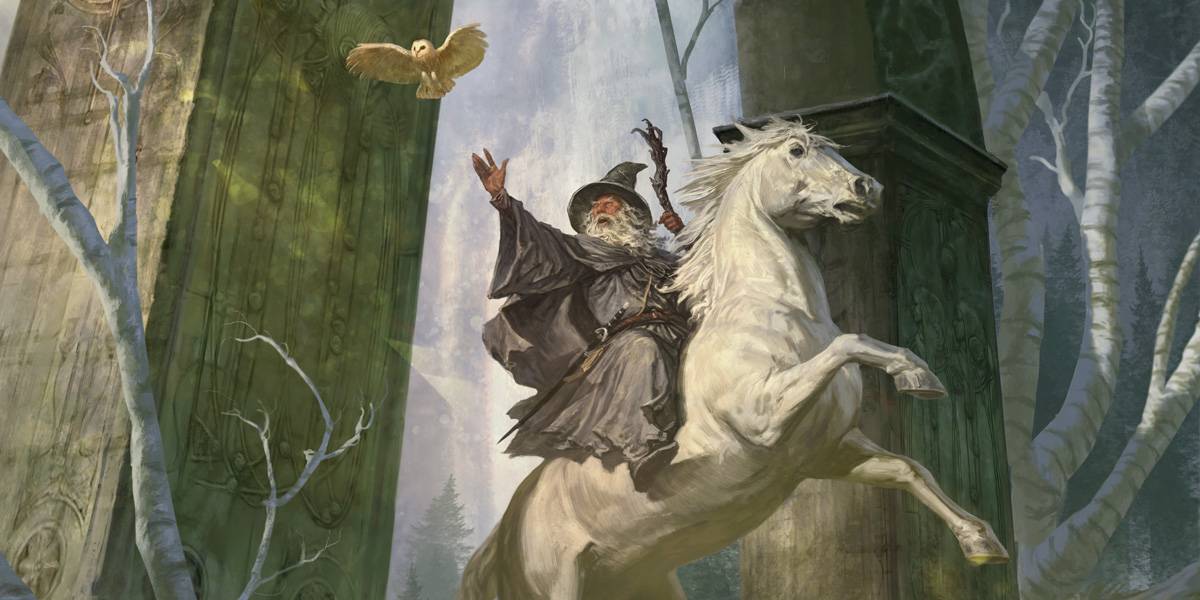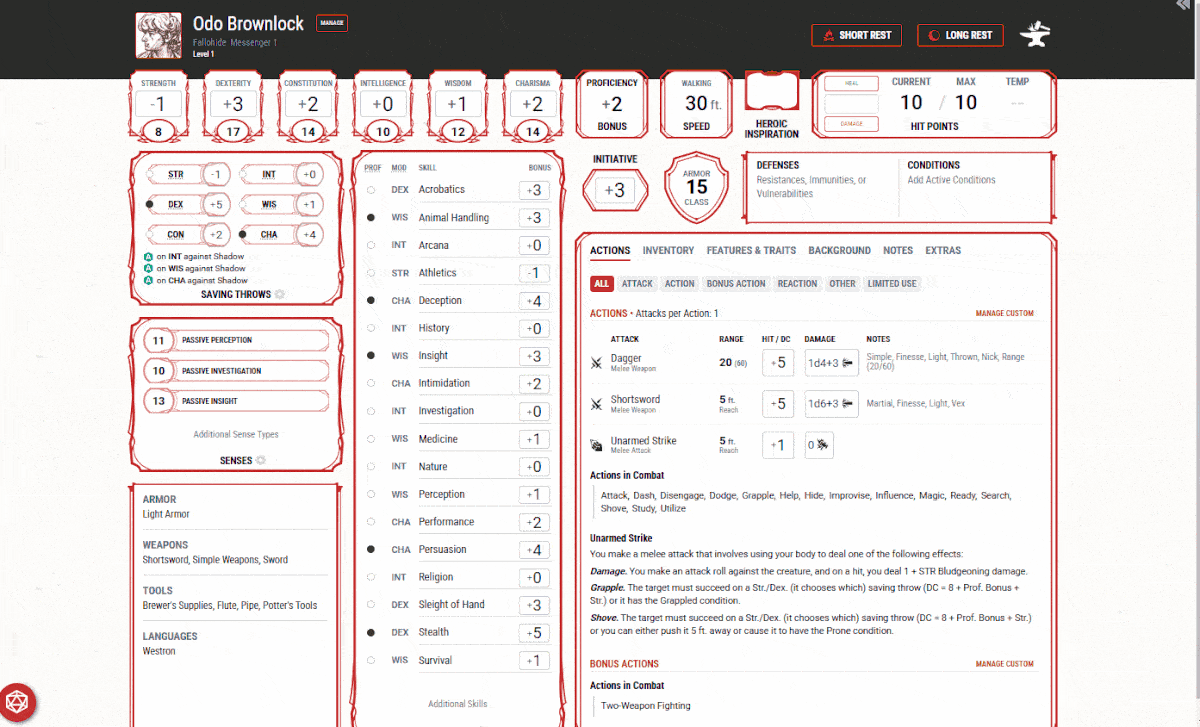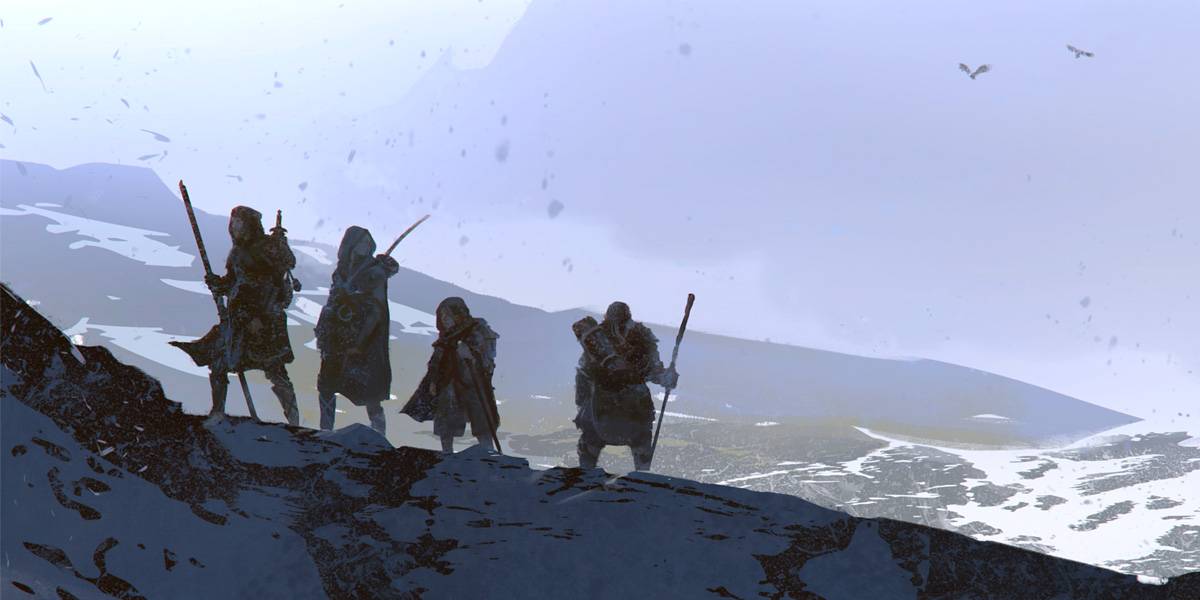It’s a dangerous business going out your door, and Free League Publishing’s The Lord of the Rings™ Roleplaying will prove it! Now on D&D Beyond, the legendary world of J.R.R. Tolkien has been adapted for fifth edition Dungeons & Dragons, including new rules for characters, setting information, monsters, and more!
Let’s explore what this volume contains and how it gives you everything you need to bring Middle-earth to life at your table!
What You’ll Find in The Lord of the Rings Roleplaying
This digital volume contains the following, all of which are designed to evoke the grounded yet epic spirit of The Lord of the Rings in your games:
- 6 Callings (the equivalent of D&D classes)
- 6 Heroic Cultures of Middle-earth (a combination of D&D species and backgrounds)
- 6 Rewards (traits that improve gear)
- 42 Virtues (the equivalent of D&D feats)
- 22 new monster stat blocks
- A full setting guide to Eriador in the Third Age
- 6 Patrons (including Gandalf!)
- New rules, including Shadow points, Councils, Journeys, and more!
All of the maps and tokens from this volume have been integrated into D&D Beyond’s toolset, so you can save time planning encounters, searching for information, or rolling up characters ready to adventure in Middle-earth!
Welcome to Middle-earth

Tolkien’s world of Middle-earth is ripe for adventure, with an ocean of deep lore, compelling geography, interesting politics, dangerous foes, and plentiful secrets.
All of the history of Middle-earth would be impossible to fit into a single tome, so The Lord of the Rings Roleplaying takes players to one of the most recognizable times and locations amongst fans: Eriador in the Third Age.
Eriador in the Third Age
The Lord of the Rings Roleplaying is set in the year 2965 of the Third Age, just 20 years after Bilbo’s perilous journey to the Lonely Mountain and roughly 50 years before Frodo first steps out his door with Sam and the One Ring.
In this volume, you’ll explore Eriador, the northwest region of Middle-earth, which is home to familiar locations, such as the Shire, the Grey Havens, Rivendell, Moria, and Bree-land. It is a wide expanse that’s not fully explored in The Lord of the Rings book trilogy or movies, leaving plenty of room for undiscovered adventures.
You’ll encounter various servants of the Shadow, uncover ancient secrets, and, if you’re lucky, run into some familiar friendly faces.
Patrons
One of the ways you can interact with Middle-earth’s more esteemed individuals is through the Patron mechanic. Some extraordinary folk have already begun the fight against the Shadow and have managed to amass the power and influence to aid our heroes. If their goals align with the party’s, these Patrons may take the heroes under their tutelage, giving them a number of benefits.
The Patron examples in this volume range from Bilbo Baggins to Gandalf the Grey and even Tom Bombadil–each of whom has a unique influence and grants advantages that can shape your journey.
The Rising Shadow
In the timeline covered by the setting, darkness has crept back into the world. While your heroes may not be confronting the Dark Lord Sauron himself, they will undoubtedly come across his deadly servants, like Evil Men, Orcs, Trolls, and Wraiths.
Throughout their adventures, your heroes must contend with these forces and the Shadow that burdens their souls. Characters can gain Shadow points, and if they accumulate an amount equal to their Wisdom score, they will suffer permanent, detrimental effects. While certain experiences and foes may make a hero gain Shadow points, they can be reduced during a Fellowship phase.
A Fellowship of Heroes

While adventures are dangerous and can make you late for dinner (or get you killed), they are the heart of every great story. Some folk are born with a spark that drives them out their door, and others have adventure thrust upon them.
In The Lord of the Rings Roleplaying, characters may feel more grounded than their typical D&D counterparts, as magic is subtler in Middle-earth. Additionally, Callings (similar to classes in D&D) only go up to level 10, ensuring that players are in for a grittier adventuring experience.
Callings
Callings represent the features a character has access to, as well as their virtues and beliefs.
The Lord of the Rings Roleplaying includes six Callings:
- Captain: A charismatic fighter who leads his fellows in battle.
- Champion: A vigorous warrior and weapon-master.
- Messenger: A swift courier with a knack for negotiation.
- Scholar: A studious, learned individual with knowledge so profound that it approximates magic.
- Treasure Hunter: A quick, nimble, and cunning burglar.
- Warden: A roaming sentinel who guards against the Shadow.
Heroic Cultures
The diverse folk of Middle-earth each have their own histories and hardships. But when adventure calls, those who answer can carve their names into legend—whether they are the descendants of great heroes or simply find themselves in the right place at the right time.
The six Heroic Cultures found in The Lord of the Rings Roleplaying are as follows:
- Bardings: Followers of King Bard and hardy survivors of Dale.
- Dwarves of Durin’s Folk: Stout warriors and craftsmen from under the mountains.
- Elves of Lindon: Immortal guardians of Middle-earth’s fading splendor.
- Hobbits of the Shire: Humble and small-sized folk with surprising bravery.
- Men of Bree: Sturdy and independent dwellers of Bree-land.
- Rangers of the North: Mysterious wanderers and exiles of a fallen kingdom with a duty to protect.
New Rules for Adventuring in Middle-earth

Whether your heroes are creeping through a dark forest, negotiating with a powerful faction, or catching up on some well-needed rest, The Lord of the Rings Roleplaying features custom rules that make gameplay feel distinct from the fifth edition of D&D:
Journeys
Perilous and spanning travel sequences are oft associated with Middle-earth, and they are vital to gameplay in The Lord of the Rings Roleplaying. The volume provides in-depth rules for journeys across the rugged, wondrous lands that stretch between bastions of civilization.
These rules are designed to make travel an integral part of every adventure, with the goal of immersing players in the wild landscape of Eriador. Characters must plot their intended path carefully, for example, avoiding crossing dangerous, swift-running rivers without bridges, and cannot dare to climb high-mountain ranges unless they know where passes are located.
Traveling in the game can be dangerous. You never know what might await heroes who venture into the wilderness. These uncertainties take the form of events that can fatigue the party and cause Exhaustion.
Councils
Social interactions of utmost importance have new rules in The Lord of the Rings Roleplaying, where they are referred to as Councils. These rules are used to simulate intense discussions between two parties that can have long-lasting ramifications.
This system includes a variety of phases in which the party needs to succeed on skill checks to convince their audience to heed their plight. The checks are made more difficult if their audience is at odds with their purpose, and things can turn out badly for parties found to be dishonest or outrageous in their requests. Think of what might happen should your heroes ask Elrond Halfelven for help, or Tom Bombadil!
Fellowship Phases
A Fellowship Phase is the downtime between adventures and can last days, weeks, or an entire season. This is the time provided for heroes to rest, reflect, and regain their strength before the next adventure.
During these phases, characters can choose from a number of undertakings that will provide lasting benefits. They can study maps, write songs, or just focus on easing the Shadow’s weight on their spirit.
It’s Time To Go on an Adventure!
The Lord of the Rings Roleplaying is now available on D&D Beyond and has been integrated with D&D Beyond’s suite of digital tools. With these aiding your quest, you can easily plot your travel with Maps, seamlessly search for content in the compendium, and roll up a hero with the Character Builder!
Will you strike out to find the remains of Annúminas and the secrets it hides? Maybe you’ll escort a Hobbit farmer along the rough roads of the Bree-land to the Inn of the Prancing Pony? Or perhaps you’ll find some good in this world that’s worth fighting for, no matter the cost.

Mike Bernier (@arcane_eye) is the founder of Arcane Eye, a site focused on providing useful tips and tricks to all those involved in the world of D&D. Outside of writing for Arcane Eye, Mike spends most of his time playing games, hiking with his girlfriend, and tending the veritable jungle of houseplants that have invaded his house.








-
View User Profile
-
Send Message
Posted Dec 13, 2024Bro threw a tantrum because his square peg wouldn't fit in a round hole. I'm with you, this system does a great job of handling role playing at the end of the Third Age of Middle Earth.
-
View User Profile
-
Send Message
Posted Dec 13, 2024There was obviously a core misunderstanding of the intention of the book. It's not to bring Lord of the Rings -based characters to a Forgotten Realms campaign running Tomb of Annihilation. It's all meant to be isolated into a Middle Earth adventure and it doesn't need to be balanced with anything outside of that scope.
-
View User Profile
-
Send Message
Posted Dec 15, 2024During the reveal video, there was some of talk about a Balrog stat-block... so I think that might not be too far away from being a thing.
-
View User Profile
-
Send Message
Posted Dec 16, 2024I do really enjoy the new features this adds.
-
View User Profile
-
Send Message
Posted Dec 31, 2024In the original novel Moria is 26 miles from one end to another, 7 layers deep, with caverns going even deeper. With 5280 feet in a mile Moria is about 10560 (26 x 5280) feet across, and roughly half as wide as it is thick. To put that into context, if you made that into a rectangle, and made a dungeon the at size out of graph paper where each square is 5 feet, and the average piece of graph paper is 44 5 foot squares across (220 ft) that would mean the 10560/220 would be 48 pieces across, and 24 pieces wide. Making 1 layer 1152 of graph paper large. Then multiply that by 7 for the differnt layers and you get a total of 92,16 pieces of graph paper. Not saying that it can't be done, but it would make Undermountain look small.
Of course that is only making a simple big rectangle and you could make it much smaller if you only mapped out certain important parts, and conected them with passages that you did not map. And just gave up on mapping most of the numerus mining operations.
I only know this because last year I attempted to make a full scale map of Moria with graph paper, but then researched how big It would end up being.
-
View User Profile
-
Send Message
Posted Jan 1, 2025dear god
-
View User Profile
-
Send Message
Posted Jan 5, 2025100 percent
-
View User Profile
-
Send Message
Posted Jan 18, 2025I purchased the content and the Virtues/Feats don't show for every character in the character builder. Why? (yes, the partnered content is checked for it)
-
View User Profile
-
Send Message
Posted Jan 19, 2025"Yeah, honey, I know the new year's party is going on and the ball's about to drop. I just have to finish this short post about Moria before coming back into the living room."
-
View User Profile
-
Send Message
Posted Jan 20, 2025I think I figured out why they weren't showing up. Most of the Virtues/Feats in this book have racial/species prerequisites and you need to be one of the races/species from the book in order for them to be used, unless you uncheck the "Use Prerequisites" Feats box in the Character Creator.
If what I assume is correct, that means there's an easy "fix", just uncheck that box, but as a GM who wants to use prerequisites, you'll have to be a bit more diligent about the descriptions of the Virtues/Feats that players are picking.
-
View User Profile
-
Send Message
Posted Jan 20, 2025Lord of the Rings Online has some amazing maps of the dungeon.